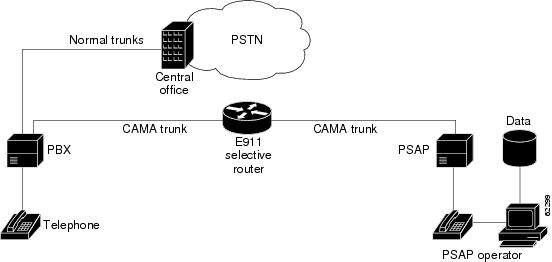Feature Overview
The North American emergency E911 phone system consists of a voice network that is built largely outside of the normal public switched telephone network (PSTN) on which common voice traffic rides. They are treated specially because they are routed differently within the PSTN than normal traffic. Calls to emergency services are routed based on the calling number, not the called number. The calling number is checked against a database of emergency service providers that cross-references the service providers for the caller's particular location. When this information is known, the call is then routed to the proper public service answering point (PSAP), which, in turn, dispatches those services for the caller's location.
During setup of a call to E911, before the audio channel is connected, the calling number is transmitted to each switching point (known as a Selective Router-SR) via an old telephony protocol known as Centralized Automatic Message Accounting (CAMA). CAMA was originally designed as a protocol for long-distance billing, because it provides for carrying both calling and called number using in-band signaling.This allows the telephone system to send a station identification number to the PSAP via multifrequency (MF) signaling through the telephone company's E911 equipment. CAMA trunks are used in 80 percent of the E911 network today.
The calling number is needed at the PSAP for two reasons:
•![]() To use the calling number to reference the Automatic Location Identification (ALI) database to find the caller's exact location and any extra information about the caller that may have been stored in the database.
To use the calling number to reference the Automatic Location Identification (ALI) database to find the caller's exact location and any extra information about the caller that may have been stored in the database.
•![]() To have the callback number in case the call is disconnected.
To have the callback number in case the call is disconnected.
A number of North American states have initiated legislation that requires enterprises to connect directly to the E911 network. It is expected that the Federal Communications Commission (FCC) will announce model legislation that extends this requirement to all North American states. Enterprises in areas where the PSTN accepts 911 calls on ISDN trunks can use existing Cisco ISDN voice-gateway products, because the calling number is an inherent part of the ISDN protocol. Most E911 networks are standalone networks within a political region, where at best the region is no bigger than a state. Because of the lack of a nationwide E911 network, customers with dispersed geographic locations larger than typical political boundaries will be required to provide E911 trunks at each political location.
Figure 1 illustrates the topography in existing E911 networks. Figure 2 illustrates an E911 network using the VIC-2CAMA card with Cisco 2600 series or Cisco 3600 series routers.
Figure 1 Existing E911 Networks

Figure 2 Analog CAMA E911 Networks

Benefits
•![]() Direct connection to the E911 network
Direct connection to the E911 network
Meets recently enacted legislation requiring enterprises to connect directly to the E911 network. This requirement is expected to expand to all US states.
•![]() Trunk capabilities to emergency services that are not currently supported on any Cisco product
Trunk capabilities to emergency services that are not currently supported on any Cisco product
•![]() Configuration on H.323 VoIP
Configuration on H.323 VoIP
Restrictions
•![]() VIC-2CAMA card installation is required
VIC-2CAMA card installation is required
•![]() Configuration in Media Gateway Control Protocol (MCGP) is not supported
Configuration in Media Gateway Control Protocol (MCGP) is not supported
•![]() Direct trunking is not supported
Direct trunking is not supported
•![]() Automatic location information (ALI) / Data Management Systems (DMS) Reverse ALI lookup features of E911 are not supported
Automatic location information (ALI) / Data Management Systems (DMS) Reverse ALI lookup features of E911 are not supported
•![]() Alternate routing for busy traffic, and night service for power failure is not supported
Alternate routing for busy traffic, and night service for power failure is not supported
Reference:
http://www.cisco.com/en/US/docs/ios/12_2t/12_2t11/feature/guide/acam_911.html#wp1042981




沒有留言:
張貼留言